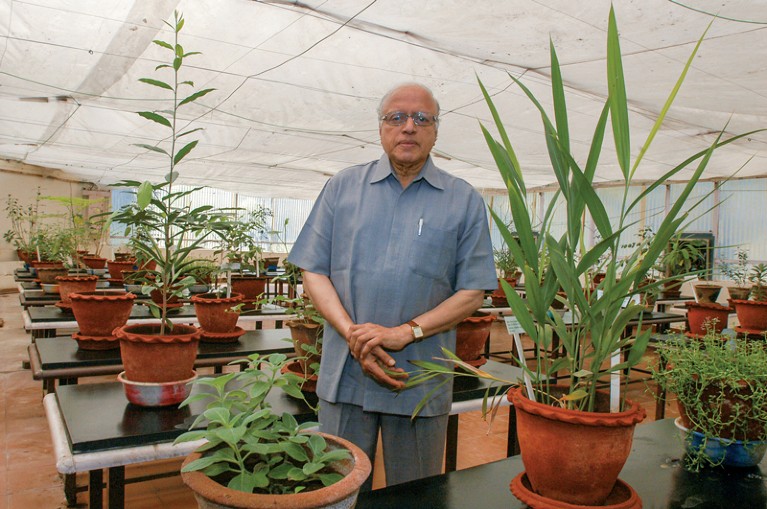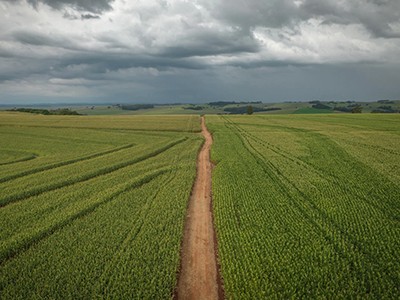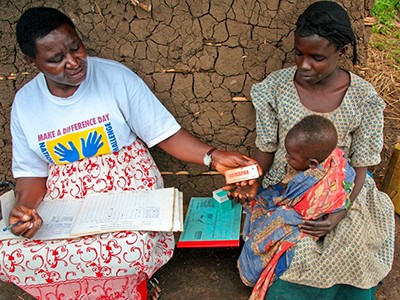
Credit: Hk Rajashekar/The The India Today Group via Getty
Agricultural scientist Mankombu Sambasivan Swaminathan rescued millions of people in South Asia from famine in the 1960s and was revered in India as the father of the agricultural movement known as the green revolution. By popularizing high-yielding wheat and rice varieties among poor farmers in South and southeast Asia, he helped to increase agricultural self-sufficiency. For this work, he received the first World Food Prize in 1987. He subsequently called for a sustainable ‘evergreen revolution’ to address the potential environmental harms of intensive farming. He has died aged 98.
Appointed in 1980 by then prime minister Indira Gandhi, Swaminathan served until 1985 on India’s Planning Commission, where he incorporated gender and environmental concerns into development planning. He advised the cabinet on science and technology, set up a biotechnology board and served on committees tackling issues from leprosy to conservation and biodiversity. Committed to eradicating nuclear weapons, he was president of the international Pugwash Conferences on Science and World Affairs from 2002 to 2007.
Swaminathan was born into an agricultural family in Kumbakonam, south India. His family supported the freedom struggle that led to India’s independence from the British Empire in 1947. Swaminathan was profoundly influenced by Mahatma Gandhi’s teachings of selfless service to poor people and the nation. After learning about the 1943 Bengal famine, which scientists now attribute mainly to poor governance by the British administration and which killed up to three million people, Swaminathan realized his calling was to improve Indian agriculture. “I had to serve my own nation,” he told his biographer R. D. Iyer (R. D. Iyer et al. M. S. Swaminathan 2nd edn; 2021).
Genetic modification can improve crop yields — but stop overselling it
In the 1960s, India was teetering on the brink of famine because of crop failure. The country had to import grain from the United States and demographers were predicting widespread starvation by the end of the decade. Swaminathan was then a junior cytogeneticist at the Indian Agricultural Research Institute in New Delhi. Tasked with improving the yields of wheat, he had immersed himself in basic research, elucidating the structure of the chromatid (half of the duplicated chromosome) to understand the kinetics of mitosis (the splitting and duplication of cells) in yeast (Nature 182, 610–611; 1958). He also investigated the effect of radiation on crops.
Swaminathan set up a ‘gamma garden’ — a one-hectare test plot surrounded by high concrete walls — where he used a radioactive source to generate random mutations in crops, which could be selected for desirable traits. These experiments placed the institute “at the forefront of agricultural research”, says P. C. Kesavan, a radiation biologist and former executive director of the M. S. Swaminathan Research Foundation in Chennai, India, and one of Swaminathan’s early students. “People would come from far and wide to meet with him.”
In 1962, Swaminathan learnt that his friend Norman Borlaug, an American plant scientist, had developed a high-yielding, short-stalked wheat crop at the International Maize and Wheat Improvement Center (CIMMYT) in El Batán, Mexico. He invited Borlaug to bring the Mexican varieties to India in March 1963. Indian scientists found that these varieties yielded more than four tonnes per hectare, rather than one tonne in control plots. The “impact on the minds of other farmers was electric”, Swaminathan recalled in a 2005 lecture at the Australian National University in Canberra. “The clamour for seeds began.” In 1968, India’s wheat yields rose to 17 million tonnes, up from 12 million tonnes four years earlier. Famine was averted and India never looked back.
Borlaug was awarded the Nobel Peace Prize in 1970 for initiating the green revolution. But Swaminathan questioned whether the revolution would be sustainable. India’s indigenous wheat varieties were tall and fell over when fertilized. By contrast, the new semi-dwarf varieties grew well in fertilized and irrigated soils. In 1968, Swaminathan told the annual Indian Science Congress that excess use of fertilizer, water, pesticides, fungicides and herbicides could damage the environment. Replacing India’s indigenous varieties with one or two strains would lower biodiversity and prove disastrous in the long run, he warned.
‘Benevolent’ patent extensions could raise billions for R&D in poorer countries
In 1982, Swaminathan was appointed director-general of the International Rice Research Institute (IRRI) in Los Baños, the Philippines. When he asked for permission to leave his government post, then prime minister Gandhi replied, “Have I hurt you in any way? I sincerely feel you are indispensable.” Swaminathan told her that he could serve his country best by working on rice at the IRRI. During his tenure, the institute developed IR-64, a rice variety that yielded up to 24% more grain than an earlier strain, IR-36. IR-64 has been grown on more than 10 million hectares worldwide and fed millions of people. Swaminathan used the money from his World Food Prize (US$200,000) to set up the M. S. Swaminathan Research Foundation. The foundation works closely with farmers to improve and disseminate agricultural science.
By the 1990s, some economists, environmentalists and social scientists were criticizing the green revolution. As farmers took to monocultures of rice, India lost around 100,000 indigenous varieties. Farmers overused fertilizers, which degraded the soil. Irrigation depleted groundwater. Swaminathan called for an ‘evergreen revolution’ that would harness technology to improve yields without harming the ecology. “It would be useful to consider recent advances in the improvement of wheat and rice to examine what midcourse corrections are needed for the purpose of adding the environmental dimension to productivity improvement,” he wrote (Crop Sci. 46, 2293–2303; 2006).
Despite the accolades, he was humble and soft-spoken, Kesavan says. When he accepted the World Food Prize, Swaminathan reminded his colleagues, “As we depart for dinner this evening, what could be a more satisfying and joyful feeling than knowing that every other member of the human family will also go to bed after a nourishing meal? Until such a wholly attainable world becomes a reality, our task remains unfinished.”

 Genetic modification can improve crop yields — but stop overselling it
Genetic modification can improve crop yields — but stop overselling it
 ‘Benevolent’ patent extensions could raise billions for R&D in poorer countries
‘Benevolent’ patent extensions could raise billions for R&D in poorer countries
 What scientists need to do to accelerate progress on the SDGs
What scientists need to do to accelerate progress on the SDGs
 I train farmers to use plant science in the fight against climate change
I train farmers to use plant science in the fight against climate change
 Millions of jobs in food production are disappearing — a change in mindset would help to keep them
Millions of jobs in food production are disappearing — a change in mindset would help to keep them
 Melaku Worede, crop genetics leader (1936–2023)
Melaku Worede, crop genetics leader (1936–2023)








